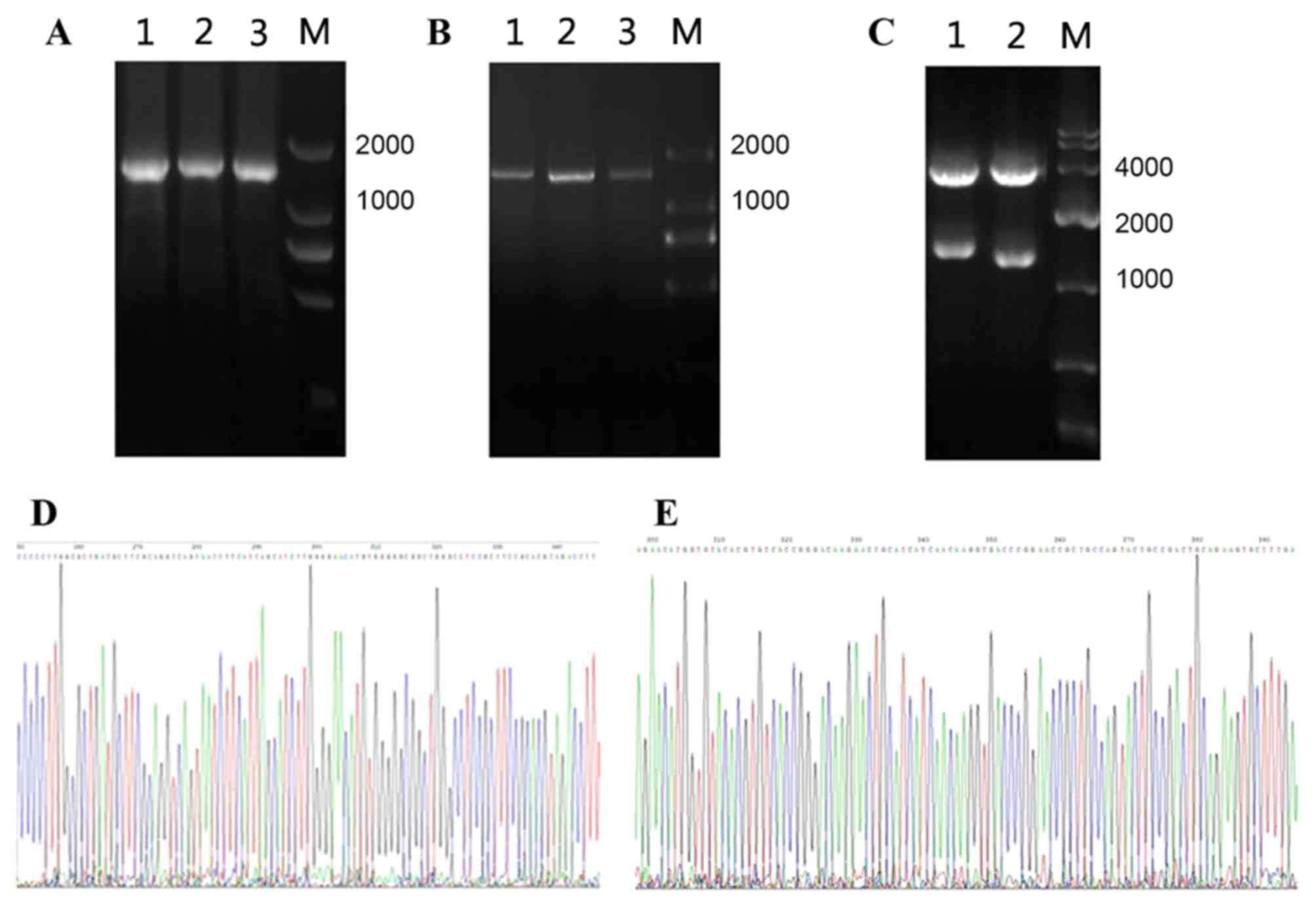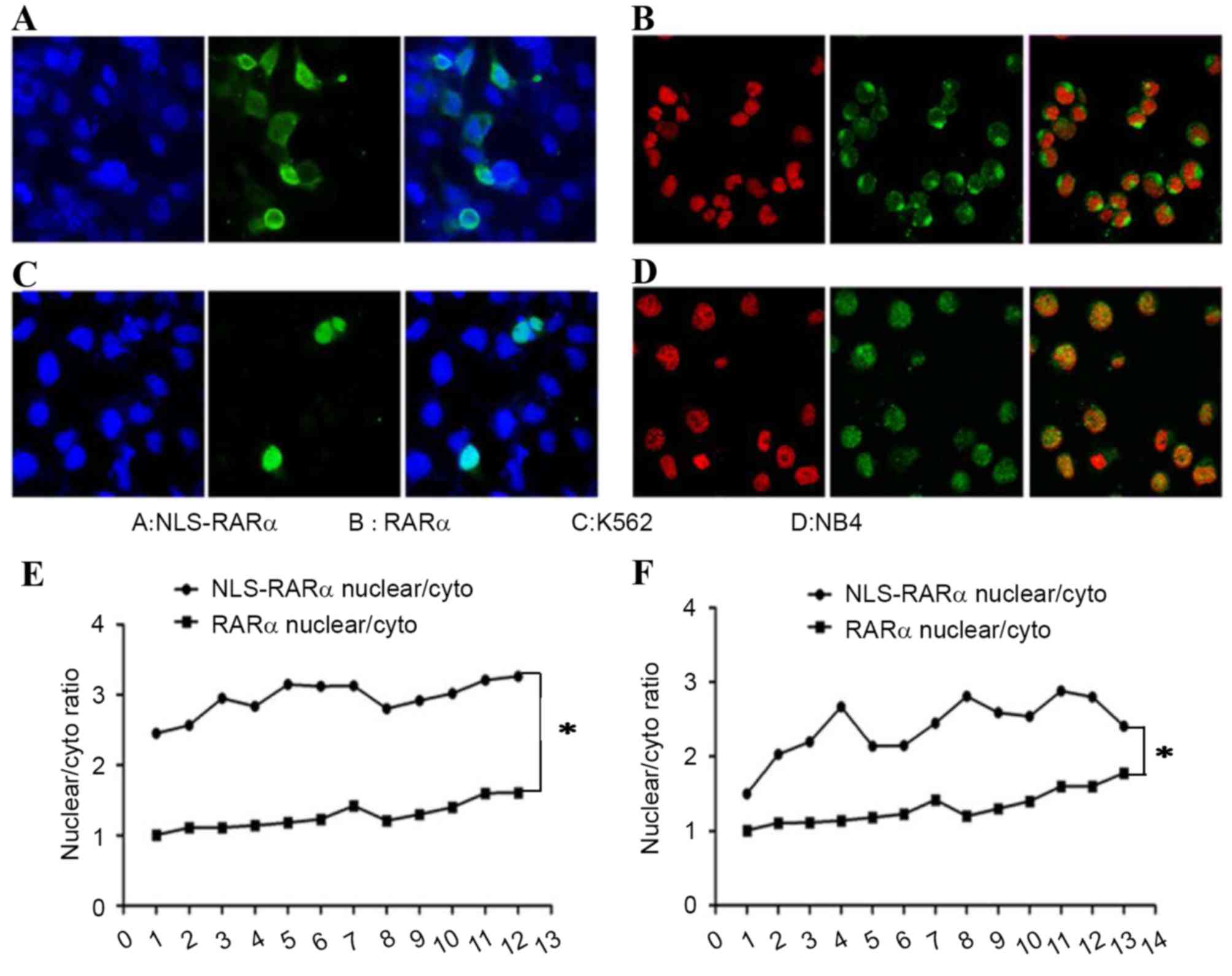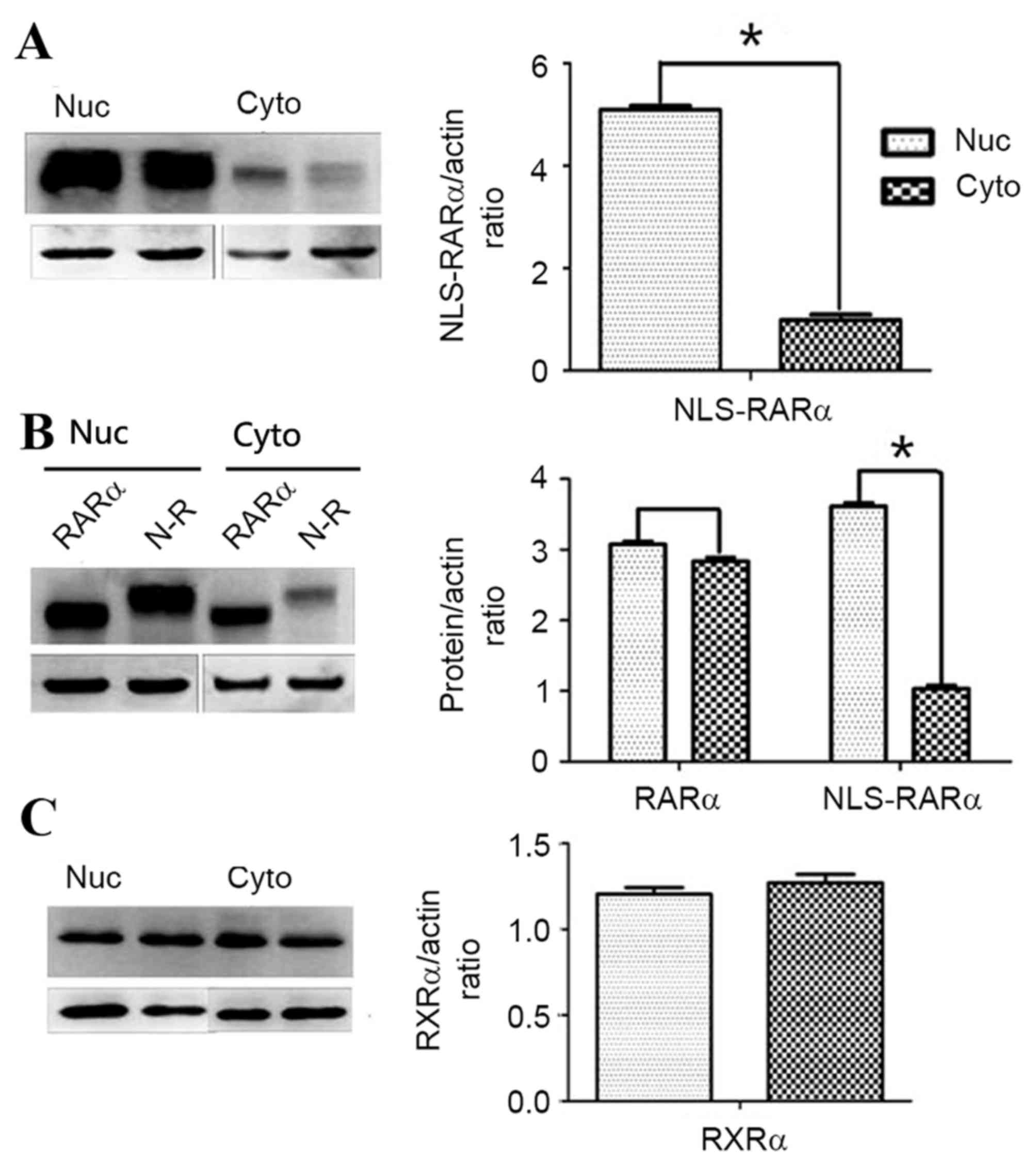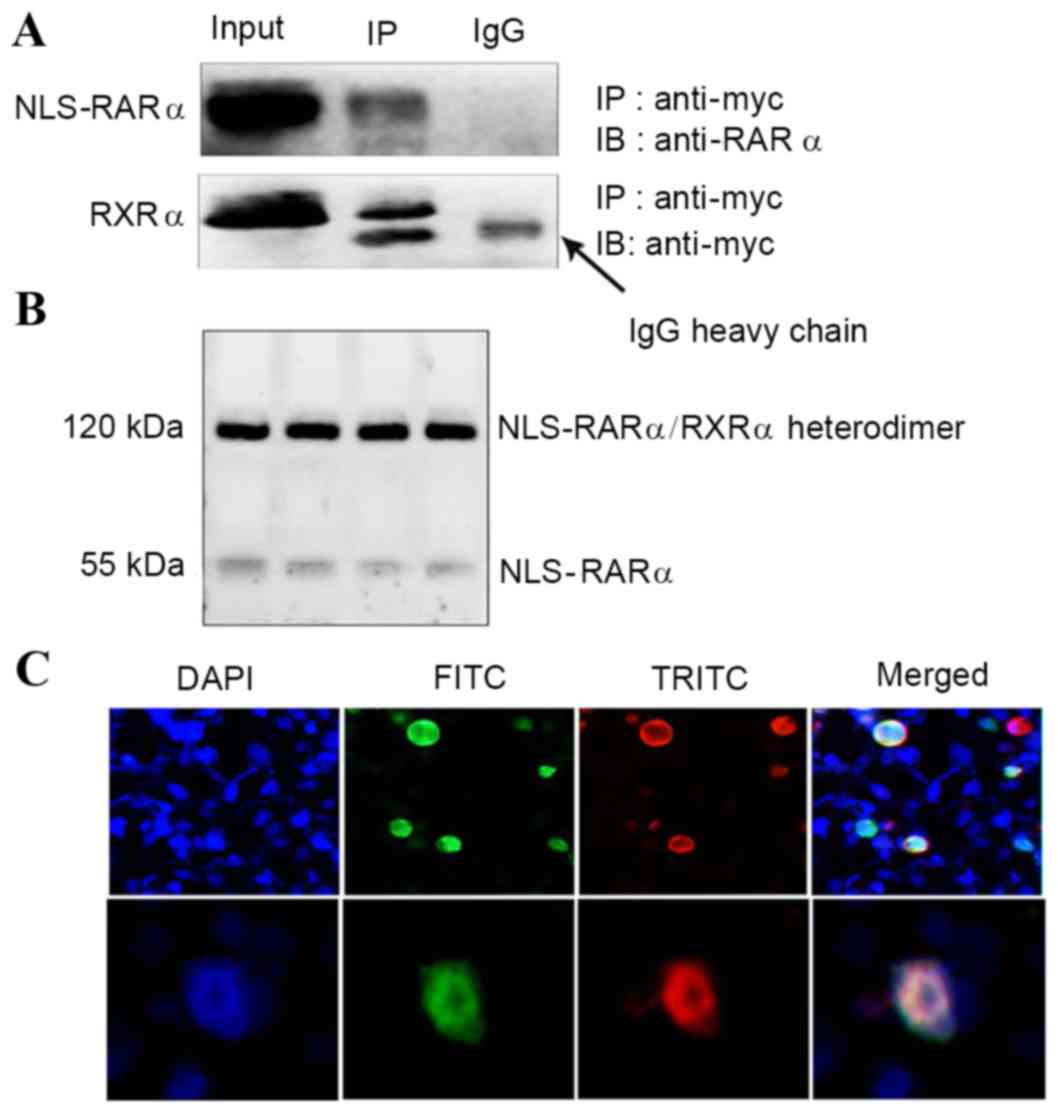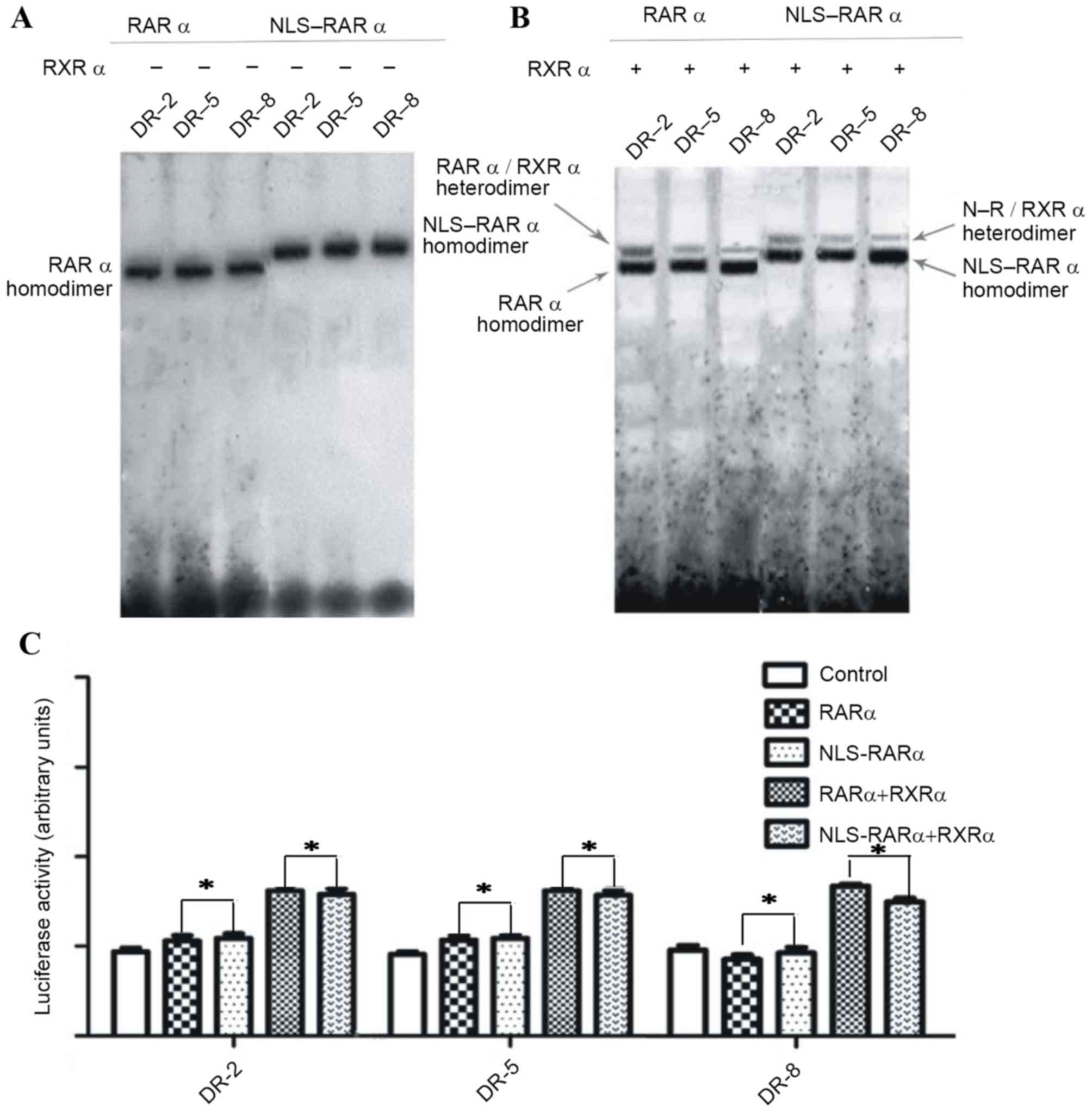NLS‑RARα is a novel transcriptional factor
- Authors:
- Published online on: October 3, 2017 https://doi.org/10.3892/ol.2017.7132
- Pages: 7091-7098
-
Copyright: © Jiang et al. This is an open access article distributed under the terms of Creative Commons Attribution License.
Abstract
Introduction
Acute promyelocytic leukemia (APL) is a clonal disease characterized by the dysregulated proliferation of abnormal promyelocytes. A non-random chromosomal translocation breakpoint, t(15;17)(q22;q21), occurs in almost every APL patient, which produces the promyelocytic leukemia (PML)-retinoic acid receptor-α (RAR-α) fusion gene, resulting in the expression of the PML-RARα fusion protein (1). Other fusion genes that cause APL also exist, including promyelocytic leukemia zinc finger protein-RARα and nucleophosmin-RARα (2). The RARα gene is a target of chromosomal rearrangements in all cases of acute promyelocytic leukemia (APL), with each fusion protein containing the same portion of the RARα polypeptide (which includes the DNA-binding and ligand-binding domains (3), a fact that highlights the key roles served by RARα in the development of APL (4,5).
RARα belongs to the nuclear receptor family and has a proven role in the differentiation of myeloid cell lines; it is also a transcriptional regulator that binds to specific retinoic acid response elements (RAREs) present in the promoters of RARα-target genes as a heterodimer with nuclear receptor retinoid X receptor-α (RXRα) (6). Numerous observations indicate that PML-RARα is a potent repressor of promelocyte differentiation (7,8). PML-RARα contributes to leukemogenesis by competitive binding of RAREs, either as a homodimer or as a heterodimer with wild-type (WT) RARα (9,10), thereby repressing gene transcription essential for myeloid differentiation. In the past few years, the development of curative approaches for APL has been the paradigm (11), but the specific mechanistic network of APL is still not fully understood (12–14). It is therefore urgent to understand more about the molecular mechanism of APL in order to develop improved, targeted drugs for the treatment of APL.
Nuclear location signal (NLS)-RARα is a cleavage variant of PML-RARα, formed on cleavage by neutrophilelastase (NE), an early-myeloid-specific serine protease, whose production is maximal in promyelocytes. NE-deficient animals were reported to be protected from development of APL (15,16). The NLS is a short sequence of amino acids that mediates the transport of nuclear proteins into the nucleus. Typically, deletion of the NLS disrupts nuclear import (17); however, the addition of NLS to RARα alters the localization of this fusion protein. Several reports indicated that protein localization alters protein functions (18–20). We hypothesized that the genes transcribed by RARα and NLS-RARα were similar and perhaps that NLS-RARα had a gain of function compared to WTRARα. NLS-RARα, following cleavage by NE, may have increased function compared with RARα, possibly dependent on protein localization and RARE-binding activity; similarities exist between NLS-RARα and the PML-RARα fusion protein. The aim of the present study was to examine the localization of NLS-RARα and the functional changes that the addition of this signal mediated. These findings may provide important information on the occurrence and development of APL.
Materials and methods
Cell culture and plasmid construction
The NB4, K562 and HEK293 cell lines were purchased from the Shanghai Institutes for Biological Sciences (Shanghai, China). The NB4 and K562 cell lines were cultured in RMPI-1640 medium (Gibco; Thermo Fisher Scientific, Inc., Waltham, MA, USA) supplemented with 10% fetal bovine serum (Gibco; Thermo Fisher Scientific, Inc.); the HEK 293 cell line was cultured in Dulbecco's modified Eagle's medium (DMEM; Gibco; Thermo Fisher Scientific, Inc.) containing 10% fetal bovine serum (Gibco; Thermo Fisher Scientific, Inc.). All cells were cultured in an environment with 5% CO2 at 37°C, and the culture liquid was changed every day. The culture liquid was changed every day. The RARα and RXRα expression constructs used for in vitro translation were generated by polymerase chain reaction (PCR) amplification of the corresponding regions of complementary DNA (cDNA) in NB4 cells and cloned into the expression vectors PCMV-HA and PCMV-mycvectors, respectively (BioVector NTCC, Inc., Beijing, China). The thermocycling conditions of RARα were: 95°C for 5 min, 98°C for 10 sec, 62°C for 35 sec, 72°C for 90 sec and 72°C for 5 min. The thermocycling conditions of RXRα were: 95°C for 5 min, 98°C for 10 sec, 59.5°C for 35 sec, 72°C for 90 sec and 72°C for 5 min. The DNA polymerase was purchased from Takara Biotechnology Co., Ltd., Dalian, China. The primers of RARα and RXRα were: RARα forward, 5′-CCGGTCGACAGATGTACGAGAGTGTAGAAG-3′ (EcoRV sequence underlined) and reverse, 5′-CCGGATATCGTCACATGGTCGGTAG-3′ (SalI sequence underlined); and RXRα forward, 5′-CCTGAATTCATGGACACCAAACATTTCCTGC-3′ (EcoRI sequence underlined) and reverse, 5′-CCTGCGGCCGCCTAAGTCATTTGGTGCGGC-3′ (NotI sequence underlined). All primers were synthesized by Takara Biotechnology Co., Ltd. NLS-RARα was amplified using pcDNA3.1-PML-RARα as a template, and then subcloned into PCMV-HA vectors.
RNA extraction and plasmid construction
Total RNA from NB4 cells was extracted using TRIzol reagent (Invitrogen; Thermo Fisher Scientific Inc.) and reverse transcribed using a PrimeScript RT reagent kit (Takara Biotechnology Co., Ltd.). The PCR reaction mixture contained 2 µl cDNA, 1 µl (20 µM) of each primer and 25 µl PremixTaq enzyme (Takara Biotechnology Co., Ltd.), with sterile water added up to a final volume of 50 µl. The reaction conditions were: Pre-denaturation at 95°C for 5 min, and then 35 cycles of denaturation at 98°C for 10 sec, annealing at 62°C (for RARα)/59.5°C (for RXRα) for 90 sec, extension at 72°C for 30 sec. The PCR products were separated on 1.5% agarose gels and stained with ethidium bromide. The fragments were then recycled from the gel and for RARα, the fragment and a PCMV-HA empty vector was digested with EcoRV and SalI (Takara Biotechnology Co., Ltd.); for RXRα, the fragment and PCMV-myc empty vector was digested with EcoRI and NotI (Takara Biotechnology Co., Ltd.), and the digested fragments and vector were ligated with T4 ligase for 6 h. The ligation product was then transformed into competent Escherichia coli. The transformation process was as follows: The ligation product was added to competent E. coli DH5α, which were placed in an ice bath for 30 min, heat shocked immediately for 90 sec at 42°C, placed into an ice bath for 2 min, and then the present study added 800 µl antibiotic-free lysogeny broth. After this step, the broth underwent shaking for 30–60 min at 37°C and 220 rpm; centrifugation for 5 min at 1,0006.2 × g produced ~100 µl supernatant. Following the resuspension of the precipitate with the supernatant, and the coating of the LB plates with 50 µg/mlkanamycin, the plates were placed in a culture incubator at 37°C. Transformed colonies were selected using the kanamycin and, 12 h later, were shaken in 5 ml lysogenybroth at 37°C. After 12 h, the plasmids were extracted using a PureYield™ Plasmid Maxiprep System kit purchased from Promega Corporation (Madison, WI, USA) and sent to Takara Biotechnology Co., Ltd. for sequencing.
Transfection and preparation of the cell extracts
A total of 1×107 HEK293 cells were seeded into10-cm dishes. Prior to transfection, the cells were cultured with DMEM for 1 h then transiently transfected with PCMV-HA-NLS-RARα (8 µg) and PCMV-myc-RXRα (8 µg) with Lipofectamine® 2000 (30 µl; Invitrogen; Thermo Fisher Scientific, Inc.) when cell confluence reached over 80%. At 6 h after transfection, DMEM was replaced with DMEM supplemented with 10% fetal bovine serum. After 2 days, the cells were collected into Eppendorf tubes and centrifuged at 96.8 × g for 5 min at 4°C, washed three times with cold PBS and suspended in radioimmunoprecipitation assay buffer and phenylmethylsulfonyl fluoride (at a ratio of 100:1) on ice. This lysis buffer contained cell extraction reagents A and B that used low osmotic pressure conditions to lyse cell membranes, releasing cytoplasmic protein. The extraction of cell proteins was achieved using a Protein Extraction kit purchased from the Beyotime Institute of Biotechnology (Haimen, China) and was performed according to the manufacturer's protocol. Nuclear proteins were obtained using a nuclear protein extraction reagent kit (P0027) purchased from the Beyotime Institute of Biotechnology in accordance with the manufacturer's protocol. The cells were then centrifuged at 15,000 × g for 15 min at 37°C, the supernatant was collected and the protein concentration was measured using a BCA assay kit (P0009) purchased from the Beyotime Institute of Biotechnology in accordance with the manufacturer's protocol.
Co-immunoprecipitation (Co-IP) and western blot analysis
A total of 1×107 cells were seeded in 10-cm dishes and 48 h after transfection, cells were lysed using IP lysis buffer from an NP-40 kit (P0013F) purchased from the Beyotime Institute of Biotechnology. The cell extracts were then incubated with the appropriate antibodies, if adding anti-RARα antibody at a given step, the present study would use anti-RXRα antibody in the following step and vice versa, or non-specific controls. Immunocomplexes were recovered by protein A/G agarose beads and resolved by electrophoresis. Cell protein (40 µg) from each group was separated by 10% SDS-PAGE and then transferred onto a polyvinylidene difluoride (PVDF) membrane. These membranes were incubated for 3 h at room temperature in 5% skimmed milk [diluted with Tris-buffered-saline with Tween-20 (TBST)] for membrane blocking. The primary antibodies used were anti-RARα rabbit polyclonal antibody (cat. no. sc-551); anti-RXRα (cat. no. sc-46659) mouse monoclonal antibody (both diluted 1:1,000; Santa Cruz Biotechnology, Inc., Dallas, TX, USA). Membranes were incubated with primary antibodies overnight at 4°C and then incubated with secondary antibody (goat anti-rabbit antibody; 1:2,000; cat. no. 127760; Beijing Zhongshan Golden Bridge Biotechnology Co., Ltd., Beijing, China) for1 h at room temperature. After washing three times with TBST, immunoreactive complexes were visualized using ECL Chemiluminescence system (Bio-Rad Laboratories, Inc., Hercules, CA, USA). β-actin served as an internal positive control.
Immunofluorescence (IF) microscopy
Transfected HEK293 cells were cytospun onto slides, fixed in 4% formaldehyde for 20 min, washed with PBS containing 0.1% Tween-20, permeabilized with 0.1% Triton X-100 solution for 10 min and washed three times with PBS. Cells were then blocked with 10% goat serum for 30 min at room temperature. After blocking, cells were immunolabelled with anti-RARα 1:200 diluted rabbit polyclonal antibodies (cat. no. sc-551) and anti-RXRα 1:200 diluted mouse monoclonal antibodies (cat. no. sc-46659) raised in the lab at 4°C overnight, washed three times in PBS and then relabelled with fluorescein isothiocyanate (FITC)-coupled goat anti-rabbit (cat. no. ZF-0314; 1:200; Zhongshan Golden bridge Biotechnology Co., Ltd.) and tetramethylrhodamine (TRITC)-coupled goat anti-mouse antibodies (cat. no. ZF-0313; 1:200; Zhongshan Golden bridge Biotechnology Co., Ltd.) at room temperature for 1 h. For nucleus staining, immunolabeled cells were incubated with DAPI or propidium iodide. A laser scanning confocal microscope was used to observe the cells.
Electrophoretic mobility shift assay (EMSA) and reporter gene assays
For the EMSA, the nuclear extract was obtained from HEK293 cells transiently transfected with PCMV-HA and PCMV-myc expression vector(s) containing NLS-RARα and RXRα by washing cells in each group with ice-cold phosphate-buffered saline and lysing them in RIPA-1640 solution (Beyotime Institute of Biotechnology) containing a protease inhibitor cocktail for 20 min at 4°C. After 24 h, 10−6 M all-trans retinoic acid (ATRA) was added to the dishes. RARα and RXRα genes were presented to the variety of the consensus binding sequences. Biotin-labeled DNA probes were synthesized by Takara Biotechnology Co., Ltd. and mixed with nuclear extract in the binding buffer as aforementioned, with 0.02 µg/µl poly (deoxyinosinic-deoxycytidylic) acid at room temperature. DNA-protein complexes and free DNA were separated on a 3.75% polyacrylamide gel. HEK293 cells were transiently transfected with luciferase reporter plasmids [RARE-2-Tk-Luc and DR5-(or 8)-Tk-Luc] and pCMV-HA-NLS-RARα, pCMV-HA-RARα using Lipofectamine 2000 (Invitrogen; Thermo Fisher Scientific, Inc.). The luciferase reporter plasmids were donated by Professor Huguesde The (Institut Universitaire d'Hématologie, Université Paris-Diderot, Paris, France). After 48 h, cells were lysed and normalized luciferase activities were determined.
Statistical analysis
Independent sample t-test was used to compare the means between two groups. All statistical analyses were performed using the SPSS 18.0 software package (SPSS, Inc., Chicago, IL, USA). All data and results presented are representative of, or calculated from, at least three independentexperiments. P<0.05 was considered to indicate a statistically significant difference.
Results
Plasmid construction
Firstly, RNA was extracted from APL cell line NB4, which was reverse transcribed into cDNA and then amplified by PCR (Fig. 1A and B). The lengths of RARα, RXRα were 1,449 and 1,389 bp respectively. Next, the fragments were digested with the appropriate restriction endonucleases. Sequencing results verified that RARα and RXRα expression plasmids had been constructed (Fig. 1).
IF result of RARα and NLS-RARα in different cell lines
RARα belongs to a family of nuclear receptors, and was revealed to localize to the nucleus and the cytoplasm. Although NLS-RARα localized to the nucleus and cytoplasm, the cytoplasmic level was far lower compared with the nuclear levels (Fig. 2A and B). Similar results were also obtained for leukemia cell lines (Fig. 2C and D). Calculation of the nuclear fluorescence intensity revealed that the level of NLS-RARα was increased compared with that of RARα, and the difference was statistically significant (P<0.05; Fig. 2E and F).
Western blot analysis of RARα and NLS-RARα
Western blot analysis confirmed the results of IF; owing to the presence of the NLS, NLS-RARα localized to the nucleus. There was a significantly increased level NLS-RARα present in the nucleus compared with that in the cytoplasm (P, 0.05; Fig. 3A and B). RXRα, like RARα, belongs to the nuclear receptor family, but was expressed equally in the nucleus and cytoplasm (Fig. 3C). Western blot analysis revealed that, the distribution of RXRα was almost equal in the nucleus and cytoplasm.
Interaction between NLS-RARα and RXRα
The retinoid signal is transduced by two families of nuclear receptors, RARs and RXRs, which formed RXR/RAR heterodimers. This means that RARα and RXRα interact with each other (21). However, whether NLS-RARα and RXRα could interact together was unclear. Co-imunopreciptation results revealed that NLS-RARα and RXRα did interact (Fig. 4A). Further experiments indicated that NLS-RARα and RXRα heterodimerized (Fig. 4B) and IF demonstrated that the two proteins co-localized (Fig. 4C).
NLS-RARα may bind and regulate the activity of RAREs
Previous studies demonstrated that RARα and RXRα could bind to specific DNA sequences or RAREs as asymmetric, oriented heterodimers in the presence of ATRA (21). Typically, RAREs are composed of two direct repeats of a core hexameric motif, PuG (G/T)TCA (20). Classical RAREs are 2, 5 and 8-bp-spaced direct repeats (referred to as DR-2, DR-5 and DR-8, respectively), and in the present study, WTRARα was revealed to bind DR-2, DR-5 and DR-8 in the presence of ATRA. NLS-RARα could also bind DR-2, DR-5 and DR-8 (Fig. 5A and B). The binding of NLS-RARα to DR-2 and DR-5 was a little weaker than WTRARα, but this was not a statistically significant difference (P>0.05). Furthermore, results of a luciferase reporter assay revealed that NLS-RARα bind the luciferase reporter plasmids and mediate their activity (P<0.05; Fig. 5C).
Discussion
APL is characterized by the aberrant proliferation of myelocyte precursor cells, whose maturation is blocked at the promyelocyte stage of granulocytic differentiation (22). The molecular marker of APL is the t(15;17)(q22;q21) translocation, which yields an aberrant PML-RARα fusion protein (23). In the absence of appropriate and prompt treatment, disseminated intravascular coagulation, owing to the secretion of plasminogen activators and lysosomal enzymes by leukemia cells, causes serious bleeding (24). In 1985, Huang et al (25) demonstrated that ATRA could induce complete remission, initiating a new era of APL therapy. However, a number of questions remain unanswered concerning APL. For example, the exact roles that alterations in RARα serve in the transformation process and the associated molecular mechanisms remain unknown. In the present study, the NLS-RARα fusion protein was revealed to be potentially involved in the pathogenesis of APL. NLS-RARα has previously been demonstrated to promote proliferation and inhibit differentiation in the APL HL-60 cell line (26). The aim of the present study was to explain the localization of NLS-RARα and assess its role as a variant transcriptional factor.
RARα belongs to nuclear receptor family and heterodimerizes with RXRα (27). The RARα/RXRα heterodimer recognizes the RAREs DR-2 and DR-5 (25). RAREs can be identified in the promoter regions of most RA-responsive genes. In the absence of agonist, RARα represses the transcription of its targets via the recruitment of several co-repressor proteins, including nuclear receptor co-repressor 2, which maintains the chromatin in an inactive state (13,28,29).
In the present study, NLS-RARα was observed to localize to the nucleus to a greater degree than WTRARα (Fig. 1). Changes in protein localization have been demonstrated to alter protein function, as the internal environment of the nucleus and cytoplasm are markedly different (17). The present study demonstrated the presence of an interaction between NLS-RARα and RXRα, and that NLS-RARα and RXRα could form heterodimers, which enabled them to bind RAREs. A previous study revealed that the PML-RARα fusion protein could competitively bind RXRα in APL, forming the PML-RARα-RXRα oligomer, which could bind an extended repertoire of response elements (8). In the present study, the transcriptional activities of the NLS-RARα variant were assessed; results from the EMSA and luciferase reporter assay indicated that the transcriptional activity of NLS-RARα was the same as WTRARα, as NLS-RARα could also bind 2-DR, 5-DR and 8-DR target probes, pointing to relaxed structural constraints for DNA binding and clarifying the function of this oncoprotein.
RARα binds to several genes involved in cell cycle regulation and transformation, including tumor necrosis factor superfamily member 13 (aproliferation-inducing ligand) (30), cyclin D1 and fibroblast growth factor 18 (31). The NLS-RARα fusion protein may interrupt the interaction between RARα and its target proteins through its stronger binding affinity to RAREs. How NLS-RARα competitively binds to RARα target genes and proteins requires further study.
In conclusion, the variant protein NLS-RARα promoted proliferation and inhibited differentiation in leukemia cells, and its localization was altered by the addition of NLS. As RARα is a transcriptional factor, the transcriptional activities of NLS-RARα were assessed and revealed to be similar to WTRARα. Therefore NLS-RARα may serve a role in APL pathogenesis by competitively binding RARα-target proteins as a variant transcriptional factor; however, further research is required to identify the proteins involved. The present study illuminated the function of NLS-RARα in APL, the molecular mechanism network of APL formation, and may aid with a greater understanding of APL.
Acknowledgements
The authors would like to thank Professor de The (Institut Universitaire d'Hématologie, Université Paris-Diderot, Paris, France) for providing the luciferase report plasmid. This study was supported by grants from the National Natural Science Foundation of China (grant no. 81171658) and the Natural Science Foundation Project of Chongqing Science and Technology Commission (grant no. 2011BA5037).
References
|
de Thé H, Le Bras M and Lallemand-Breitenbach V: The cell biology of disease: Acute promyelocytic leukemia, arsenic, and PML bodies. J Cell Biol. 198:11–21. 2012. View Article : Google Scholar : PubMed/NCBI | |
|
Zelent A, Guidez F, Melnick A, Waxman S and Licht JD: Translocations of the RARalpha gene in acute promyelocytic leukemia. Oncogene. 20:7186–7203. 2001. View Article : Google Scholar : PubMed/NCBI | |
|
Melnick A and Licht JD: Deconstructing a disease: RARalpha, its fusion partners and their roles in the pathogenesis of acute promyelocytic leukemia. Blood. 93:3167–3215. 1999.PubMed/NCBI | |
|
Chang KS, Stass SA, Chu DT, Deaven LL, Trujillo JM and Freireich EJ: Characterization of a fusion cDNA (RARA/myl) transcribed from the t(15;17) translocation breakpoint in acute promyelocytic leukemia. Mol Cell Biol. 12:800–810. 1992. View Article : Google Scholar : PubMed/NCBI | |
|
Zhou GB, Chen SJ and Chen Z: Acute promyelocytic leukemia: A model of molecular target based therapy. Hematology. 10 Suppl 1:S270–S280. 2005. View Article : Google Scholar | |
|
Raelson JV, Nervi C, Rosenauer A, Benedetti L, Monczak Y, Pearson M, Pelicci PG and Miller WH Jr: The PML/RAR alpha Oncoprotein is a direct molecular target of retinoic acidin acute promyelocytic leukemia cells. Blood. 88:2826–2832. 1996.PubMed/NCBI | |
|
Zhou J, Pérès L, Honoré N, Nasr R, Zhu J and de Thé H: Dimerization-induced corepressor binding and relaxed DNA-binding specificity are critical for PML/RARA-induced immortalization. Proc Natl Acad Sci USA. 103:pp. 9238–9243. 2006, View Article : Google Scholar : PubMed/NCBI | |
|
Kamashev D, Vitoux D and De Thé H: PML-RARA-RXR oligomers mediate retinoid and rexinoid/cAMP cross-talk in acute promyelocytic leukemia cell differentiation. J Exp Med. 199:1163–1174. 2004. View Article : Google Scholar : PubMed/NCBI | |
|
Zhu J, Nasr R, Pérès L, Riaucoux-Lormière F, Honoré N, Berthier C, Kamashev D, Zhou J, Vitoux D, Lavau C and de Thé H: RXR is an essential component of the oncogenic PML/RARA complex in vivo. Cancer Cell. 12:23–35. 2007. View Article : Google Scholar : PubMed/NCBI | |
|
Vitaliano-Prunier A, Halftermeyer J, Ablain J, de Reynies A, Peres L, Le Bras M, Metzger D and de Thé H: Clearance of PML/RARA-bound promoters suffice to initiate APL differentiation. Blood. 124:3772–3780.. 2014. View Article : Google Scholar : PubMed/NCBI | |
|
Ablain J and de The H: Revisiting the differentiation paradigm in acute promyelocytic leukemia. Blood. 117:5795–5802. 2011. View Article : Google Scholar : PubMed/NCBI | |
|
Huang Y, Qiu J, Chen G and Dong S: Coiled-coil domain of PML is essential for the aberrant dynamics of PML-RARalpha, resulting in sequestration and decreased mobility of SMRT. Biochem Biophys Res Commun. 365:258–265. 2008. View Article : Google Scholar : PubMed/NCBI | |
|
de Thé H and Chen Z: Acute promyelocytic leukemia: Novel insights into the mechanisms of cure. Nat Rev Cancer. 10:775–783. 2010. View Article : Google Scholar : PubMed/NCBI | |
|
Ablain J and de Thé H: Retinoic acid signaling in cancer: The parable of acute promyelocytic leukemia. Int J Cancer. 135:2262–2272. 2014. View Article : Google Scholar : PubMed/NCBI | |
|
Lane AA and Ley TJ: Neutrophil elastase cleaves PML-RARalpha and is important for the development of acute promyelocytic leukemia in mice. 115:305–318. 2003. | |
|
Hayakawa F and Privalsky ML: Phosphorylation of PML by mitogen-activated protein kinases plays a key role in arsenic trioxide-mediated apoptosis. Cancer Cell. 5:389–401. 2004. View Article : Google Scholar : PubMed/NCBI | |
|
Cokol M, Nair R and Rost B: Finding nuclear localization signals. EMBO Rep. 1:411–415. 2000. View Article : Google Scholar : PubMed/NCBI | |
|
Zhang XW, Yan XJ, Zhou ZR, Yang FF, Wu ZY, Sun HB, Liang WX, Song AX, Lallemand-Breitenbach V, Jeanne M, et al: Arsenic trioxide controls the fate of the PML-RARalpha oncoprotein by directly binding PML. Science. 328:240–243.. 2010. View Article : Google Scholar : PubMed/NCBI | |
|
Wu TT, Chen C, Chen SM, Xu Y, Wang Y, Chen Z, Wang F, Xiao BK and Tao ZZ: Nuclear translocation of telomerase reverse transcriptase is a critical process in lymphatic metastasis of nasopharyngeal carcinoma. Oncol Lett. 9:265–269. 2015.PubMed/NCBI | |
|
Sánchez-Quesada C, López-Biedma A and Gaforio JJ: The differential localization of a methyl group confers a different anti-breast cancer activity to two triterpenes present in olives. Food Funct. 6:249–256. 2015. View Article : Google Scholar : PubMed/NCBI | |
|
Altucci L, Leibowitz MD, Ogilvie KM, de Lera AR and Gronemeyer H: RAR and RXR modulation in cancer and metabolic disease. Nat Rev Drug Discov. 6:793–810. 2007. View Article : Google Scholar : PubMed/NCBI | |
|
McCulloch D, Brown C and Iland H: Retinoic acid and arsenic trioxide in the treatment of acute promyelocytic leukemia: Current perspectives. Onco Targets Ther. 10:1585–1601. 2017. View Article : Google Scholar : PubMed/NCBI | |
|
Kakizuka A, Miller WH Jr, Umesono K, Warrell RP Jr, Frankel SR, Murty VV, Dmitrovsky E and Evans RM: Chromosomal translocation t(15;17) in human acute promyelocytic leukemia fuses RAR alpha with a novel putative transcription factor, PML. Cell. 66:663–674. 1991. View Article : Google Scholar : PubMed/NCBI | |
|
Choudhry A and DeLoughery TG: Bleeding and thrombosis in acute promyelocytic leukemia. Am J Hematol. 87:596–603. 2012. View Article : Google Scholar : PubMed/NCBI | |
|
Huang ME, Ye YC, Chen SR, Chai JR, Lu JX, Zhoa L, Gu LJ and Wang ZY: Use of all trans retinoic acid in the treatment of acute promyelocytic leukemia. Blood. 72:567–572. 1988.PubMed/NCBI | |
|
Hu XX, Zhong L, Zhang X, Gao YM and Liu BZ: NLS-RARα promotes proliferation and inhibits differentiation in HL-60 cells. Int J Med Sci. 11:247–254. 2014. View Article : Google Scholar : PubMed/NCBI | |
|
de Thé H, Lavau C, Marchio A, Chomienne C, Degos L and Dejean A: The PML-RAR alpha fusion mRNA generated by the t(15;17) translocation in acute promyelocytic leukemia encodes a functionally altered RAR. Cell. 66:675–684. 1991. View Article : Google Scholar : PubMed/NCBI | |
|
Zelent A, Guidez F, Melnick A, Waxman S and Licht JD: Translocations of the RARalpha gene in acute promyelocytic leukemia. Oncogene. 20:7186–7203. 2001. View Article : Google Scholar : PubMed/NCBI | |
|
Bastien J and Rochette-Egly C: Nuclear retinoid receptors and the transcription of retinoid-target genes. Gene. 328:1–16. 2004. View Article : Google Scholar : PubMed/NCBI | |
|
Planelles L, Medema JP, Hahne M and Hardenberg G: The expanding role of APRIL in cancer and immunity. Curr Mol Med. 8:829–844. 2008. View Article : Google Scholar : PubMed/NCBI | |
|
Delacroix L, Moutier E, Altobelli G, Legras S, Poch O, Choukrallah MA, Bertin I, Jost B and Davidson I: Cell-specific interaction of retinoic acid receptors with target genes in mouse embryonic fibroblasts and embryonic stem cells. Mol Cell Biol. 30:231–244. 2010. View Article : Google Scholar : PubMed/NCBI |



